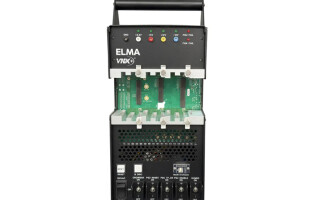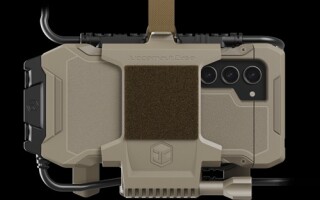The need for interoperability standards in SATCOM for unmanned systems
StoryApril 20, 2020

Unmanned systems are increasingly being integrated into Department of Defense (DoD) strategies. Counterterrorism missions, for example, would not have achieved success without these unmanned platforms. As the DoD, industry and academia develop more advanced technologies in support of unmanned systems and platforms, including satellite communications (SATCOM), it is imperative that interoperability standards be developed and implemented to accelerate unmanned technology. Hughes Defense sees adopting SATCOM-related open-systems standards as central to achieving interoperable, resilient communications for unmanned systems. Using such open architectures, especially those that support resilient communications for unmanned aircraft systems (UASs), will strengthen warfighting to manage today’s near-peer adversaries.
Since the Gulf War during the 1990s, military users have grown accustomed to satellite communications (SATCOM) applications, from fixed to new mobility applications. As network-centric warfare, data-driven systems, and user demands have converged, bandwidth consumed per 5,000 military members has exploded from single-digit megabits per second (Mbits/sec) usage in the 1990s to more than 350 Mbits/sec in 2020.1
Soldiers are especially reliant on higher data rates for communications on the move (COTM), where users can stay connected with video information as well as voice while traversing the battlefield. U.S. Special Operations Command J6 director John Wilcox spoke about mobility in May 2017, referencing SATCOM’s value in successfully executing special operations in the expeditionary environment where “… operators must be able to operate anywhere at any time.”2
Unmanned aircraft systems (UASs) are the next SATCOM frontier: For nearly two decades, the Department of Defense (DoD) and the Office of the Secretary of Defense (OSD) together have focused on incorporating UASs across every warfighting domain based on their success in the recent past. We now see UAS coming into standard use, and with that, increasing demand for onboard, beyond-line-of-sight (BLoS) SATCOM solutions.
Interoperability of SATCOM systems is essential for UAS applications. Standards will accelerate battlefield decision-making so data can be collected and used for reliable, rapid deployment operations, focused on delivering what is dubbed E.P.I.C. Speed (Enterprise, Partnerships, Innovation, Culture, and Speed) to protect against persistent, technologically advanced adversaries.
Early efforts at interoperability
As UASs have become more militarily valuable, attempts have been made to establish SATCOM standards to support the distinct needs of unmanned missions. A 2005 GAO report noted that UAS could not easily transmit and receive data among different communications, sensor, and ground systems as these technologies were not interoperable. NATO recognized this problem and in 2007 created the Standardization Agreement 4586 to define the interface between a ground control system and an unmanned system in an aerial vehicle. In 2008, the DoD issued an “Unmanned Systems Interoperability” profile to implement standards for UAS open architecture specifications. U.S. Central Command field experience with UAS during Persian Gulf operations contained limited communications interoperability, as service-specific UAS development programs did not address broad enterprise-wide needs.
As of early 2016, DoD initiated an effort across all military services to create common standards, architectures, and technologies for unmanned systems, focused primarily on UASs, including the communications architecture. This work is slowly progressing with incremental funding to improve much-needed interoperability for all domains. However, attention must be paid to interoperability across three key areas: antennas/modems, mechanical interfaces, and networks.
Three keys to SATCOM interoperability for UAS
The first key to UAS SATCOM interoperability is open standards for airborne satellite antennas and modems. For UAS applications, the SATCOM terminal modem and antenna must work together closely to transmit geographic location, satellite handoff, beam quality, and other critical data. Long-duration COTM applications like those using aircraft rely on this coordination to ensure successful satellite beam switching while the aircraft moves.
To meet these needs, antenna manufacturers and modem providers offered proprietary protocols to support DoD’s early tech modernization, severely limiting end-user choice and flexibility and tying users to one service provider. Decision-makers have learned that such a siloed approach does not deliver the critical resilience they need in all environments for all applications. Designing these hardware elements using an open systems architecture approach enables technology evolution to support long-term modernization, lowering costs and ensuring timely technology enhancements.
The Open Antenna to Modem Interface Protocol (Open-AMIP) development process, initiated by equipment manufacturers in 2006, represents progress in creating best-in-class airborne solutions. The DoD has started to adopt commercial Open-AMIP antenna control units, improving SATCOM resilience for COTM as well as providing the best available technology for an enterprise-wide SATCOM architecture. This standard can maximize the interoperability DoD and OSD have outlined for UAS and deliver much-needed operational advantages in today’s contested airborne battlespace.
A second important portion is standardized mechanical interfaces for SATCOM terminals on UASs. Thousands of aircraft worldwide will add airborne SATCOM terminals in the coming decade, creating the need for more open standards for the mechanical interfaces. UAS platforms will require this same technical coordination. Aircraft industry suppliers are working with SATCOM terminal manufacturers to set new standards to simplify and streamline adoption of high-data rate SATCOM. This includes ARINC and other standards that define how to architect and interconnect software and electrical interfaces.
Environmental standards must be defined as well to ensure airborne SATCOM equipment can overcome hurdles ranging from extreme operating temperature, high shock and vibration, to extremely low EMI profile, lightning immunity and other safety and security challenges.
The third piece of this UAS SATCOM puzzle is network interoperability: SATCOM interoperability for UAS also requires network considerations to support efficient information sharing and flexible mission objectives. According to the Army’s future UAS strategy, the overarching objective is to synchronize UAS equipment with the human and networking elements. Commonality and an open-architecture systems approach are fundamental to the Army’s UAS strategy. Open design enables potential control and integration of multiple platforms simultaneously, even across operational domains. Open architectures also enable component upgrades to be interchangeable among different platforms.
In the near term, DoD services will retrofit parts for interchangeability and modularity in legacy systems. Such network interoperability will also mitigate vulnerabilities and prevent data disruption or manipulation. (Figure 1.)
Figure 1 | Interoperability Roadmap: Comprehensive Roadmap for Interoperability, Unmanned Systems Integrated Roadmap FY 2017-2042. Source: Defense Daily.
|
|
The interoperability imperative for UAS
UASs are poised to support achievement of the nation’s security goals, but siloed SATCOM solutions present a barrier that must be overcome. The Joint Staff – in documents released in early 2019 that focused on DoD’s satellite communications – mentioned interoperability several times. These references included SATCOM system planning which must leverage technology improvements and assist in synchronizing terminal development and fielding to maximize operational benefits like stronger terminal control, greater situational awareness, heightened efficiency, and enhanced protection. Warfighters require rapid improvements to reconnect isolated war zones within a few days versus a few weeks or months.
Hughes Defense has introduced modem and service management technology that enables autonomy and flexibility for enhanced, protected communications – even using legacy modems and waveforms. The Hughes Flexible Modem Interface (FMI) leverages advanced artificial intelligence (AI) and software-defined networking so terminals can select a modem and service autonomously following policy rules assigned to various factors, such as mission priority, satellite availability, cost considerations, and active threats.
To meet a wide variety of mobility requirements – including UASs – the company’s HM System employs a commercially based, open-standards architecture with a software-definable modem and advanced waveform and a frequency band-agnostic platform.
Standardizing protocols and network connection types will offer significant cost and operational efficiencies by requiring fewer hardware types to operate, maintain, and refresh. This fact applies to the DoD’s approximately 17,000 wideband user terminals managed across 135 designs. The DoD spends an average of $4 billion each year to acquire and sustain wideband satellite communications capabilities, including developing and fielding military satellite systems, contracting for commercial SATCOM services, and acquiring and operating satellite ground terminals.
Antenna and radio frequency interface-related costs account for approximately 50% of the overall development and fielding cost for a new terminal. With these numbers, imagine the possibilities interoperability will yield.
What’s next?
Future warfare will hinge on critical, efficient interactions across warfighting systems all along the military enterprise. An interoperable foundation will ensure timely exchange of information among information gatherers, decision-makers, planners, and warfighters, and spur future opportunities for interoperability as new mission needs arise for both UASs and communications systems. Although challenging to develop and implement, interoperability standards will lead to open architectures, innovation, and cost savings for UAS SATCOM.
References
1 https://apps.dtic.mil/dtic/tr/fulltext/u2/a488621.pdf
2 https://asianmilitaryreview.com/2018/03/satcom-on-the-move
Rick Lober is the Vice President and General Manager of the Defense and Intelligence Systems Division (DISD) at Hughes Network Systems. In this role, he is responsible for applying the company’s broad range of SATCOM technologies and services to the worldwide defense marketplace and the intelligence community. This includes both fixed Ku-, Ka-, and X-band VSAT and mobilesat products and systems. Applications cover satellite communications-on-the-move for both ground-based and airborne platforms along with numerous classified development programs. He has more than 25 years of experience with both COTS-based and full MIL communications and intelligence products, systems, and major programs, starting as a design engineer and progressing to an executive role. Readers may reach the author at rick.lober@hughes.com.
Hughes Network Systems
www.hughes.com







